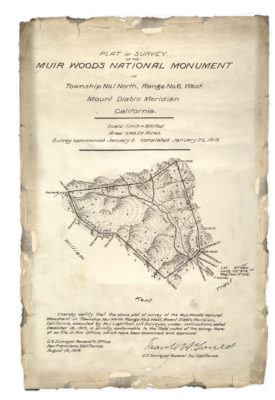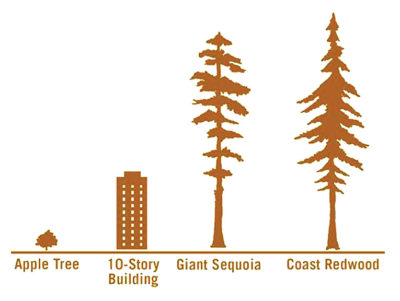A Proclamation
 Now, Therefore, I, Theodore Roosevelt, President of United States of America, by virtue of the power and authority in me vested … do hereby declare and proclaim that said grove and all of the land hereinbefore described… set apart as a National Monument, to be known and recognized as the Muir Woods National Monument…”
Now, Therefore, I, Theodore Roosevelt, President of United States of America, by virtue of the power and authority in me vested … do hereby declare and proclaim that said grove and all of the land hereinbefore described… set apart as a National Monument, to be known and recognized as the Muir Woods National Monument…”
On January 9, 1908, with just the stroke of a pen, President Theodore Roosevelt used the powers of the Antiquities Act to create Muir Woods National Monument in Marin County, California.
This proclamation and others can be found under a set of records called Control Document Index cards on the General Land Office Branch website.
 The documents in Control Document Index affect or have affected the status of public lands, including those documents that control, limit, or restrict the availability of right or title to, or use of public lands. Some of these documents include:
The documents in Control Document Index affect or have affected the status of public lands, including those documents that control, limit, or restrict the availability of right or title to, or use of public lands. Some of these documents include:
- Executive Orders
- Presidential Proclamations
- Public Land Orders
- Other documents, such as deeds that convey title to public lands to the United States, including quit claim deeds, acquired easements, condemnation judgments, and warranty deeds.
The Preservation of Giants
 Muir Woods National Monument is located only eight miles north of San Francisco, California in Marin County and is known for its old-growth coastal redwoods, Sequoia sempervirens.
Muir Woods National Monument is located only eight miles north of San Francisco, California in Marin County and is known for its old-growth coastal redwoods, Sequoia sempervirens.
Coastal redwoods are the tallest trees in the world. They can reach over 300 feet high and 25 feet round. These trees can also live for over 2,000 years!
The Muir Woods preserve these magnificent giants on land that was gifted from a philanthropist and
conservationist named William Kent.
 In 1905, William Kent and his wife, Elizabeth Thacher Kent, bought 295 acres along Redwood Creek in Marin County for $45,000. To protect the beautiful stands of redwoods there, the Kents donated the land to the United States Federal Government. The land was gifted through a quit claim deed.
In 1905, William Kent and his wife, Elizabeth Thacher Kent, bought 295 acres along Redwood Creek in Marin County for $45,000. To protect the beautiful stands of redwoods there, the Kents donated the land to the United States Federal Government. The land was gifted through a quit claim deed.
Based on these letters, you can see that Theodore Roosevelt wanted to name the monument after William Kent, but Mr. Kent insisted the monument be named after John Muir.